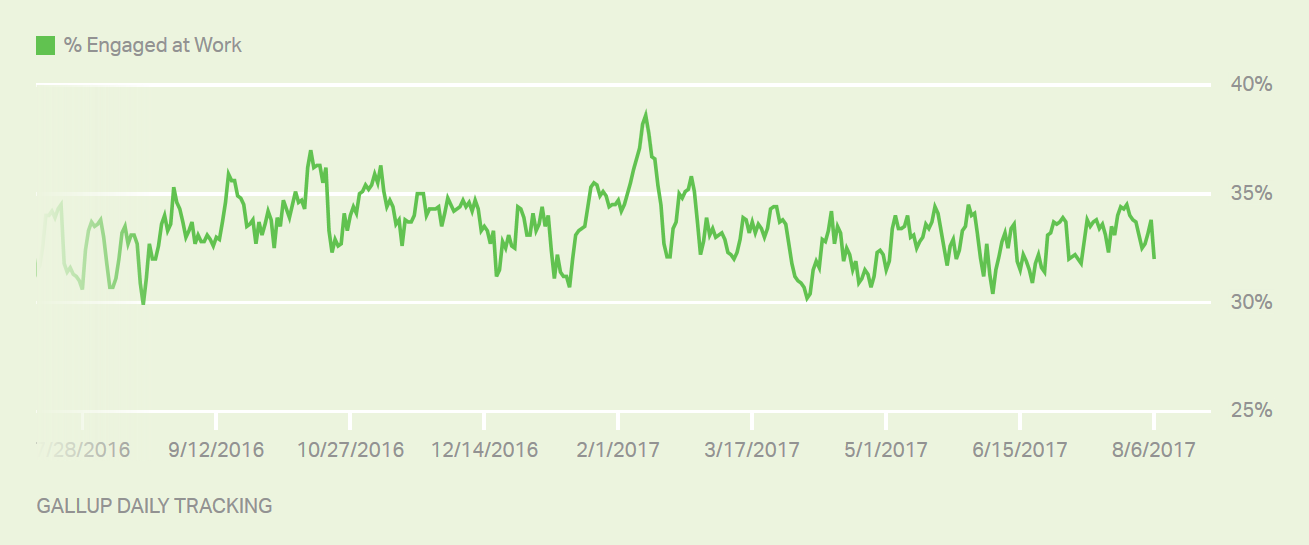Employee engagement is something every (or nearly every) employer hopes for. According to research from Gallup, only 30%* of employees are engaged in their jobs. Does that mean 70% of employees are not engaged?
Yes and no.
There is a spectrum of engagement. But what is engagement?
What is engagement?
Gallup lists three types of workers: engaged, not engaged, and actively disengaged.
Engaged
Engaged employees are “psychologically committed” to their projects and go the extra mile to ensure the success of the organization. They want to see the business flourish and focus on bringing innovation and energy to the table.
Their motto? “Let’s do this!”
Not Engaged
Not engaged describes your average employee. They don’t strive for great outcomes, nor do they intentionally slack off. Sometimes their thoughts focus on the task at hand, sometimes they don’t. These employees can be influenced by the Engaged or Disengaged.
Their motto? “Meh.”
Disengaged
This group of employees is harmful to the well being of an organization. They purposefully seek out ways to undermine and damage the business. They intentionally submit work with errors or create a toxic work environment with their negative attitude.
Their motto? “I’m bringing you down with me.”
Why does engagement matter?
Why does engagement matter? “Unengaged” employees are more likely to under-perform. Productivity and finding replacements result in lost time and money.
What’s an employer to do? The obvious answer is “improve engagement” by taking two actions. One, moving employees from not engaged to engaged. Two, finding ways to engage or remove actively disengaged employees.
However, the obvious answer is not necessarily the simple answer. There is no magic equation to create engaged employees.
Thankfully, there are several opportunities for employers to increase engagement using benefits. When an organization invests in its employees’ well-being by offering a strong benefits package, it develops trust and improves engagement.
Increase Engagement Using Benefits
Set an Enrollment Goal
Before you set out to improve something, you need to understand where you are and where you want to be.
In a place with heavy foot traffic, display enrollment numbers from previous years, then set a higher goal for the current year.
Example Goals
- Drive enrollment into a lower cost option
- Encourage enrollment in a pre-tax benefit program
- Incentivize employees to increase their pre-tax elections
Be sure to set specific, measurable goals and drive actions toward it.
Provide Frequent Reminders
Consider sending company communications several weeks (or even months) before Open Enrollment begins. Emails can fall through the cracks, with most people sending and receiving an average of 123 emails per day. If possible, send reminders from various sources, such as the company CEO or owner, Human Resources, and individuals’ direct managers.
Also, while frequent communication during Open Enrollment is important, it’s wise to keep benefits discussions going year-round. Send reminders throughout the year regarding the benefits available.
If you offer a commuter benefit plan, encourage employees to enroll throughout the year. Employers can also promote wellness programs, 401K contributions, discount programs, employee assistance programs or other non-traditional benefits that are available all year long.
During Open Enrollment conversations, secondary benefits often get lost. Engage employees year-round by reminding them of all of the benefits available to them, not just the primary ones.
Meet Halfway on Accountability
True or False? It’s not the HR Director’s job to walk every employee through enrollment.
True or False? Each employee is responsible for timely enrollment in his/her benefits.
Typically, the correct response is “True” to both of these questions. However, companies may see more employees enrolling if both sides agree to meet in the middle.
Although the responsibility to enroll falls on employees, HR personnel can consider holding office hours during Open Enrollment. Whether achieved through one-on-one meetings or small group meetings, both ensure employees who need more assistance receive it.
Another option is for HR to host a webinar addressing FAQs around benefits and the enrollment process.
Make Time for Benefits at Work
Once home with family or engaged in other commitments, employees have little time to manage their benefits. During Open Enrollment, consider setting aside time during the work day for employees to focus on enrollment options.
For those employees who will look at benefits outside of work (or are reviewing benefits with a significant other), ensure they have convenient access to decision support tools. Resources—such as online portals and mobile apps— provide quick and convenient options for employees to review and compare their benefits options.
Additionally, you may need to evaluate the support you make available to spouses and significant others as they can often be the ultimate decision-makers.
Share How-To Articles
Provide a list of “How to” or educational articles relating to benefits enrollment or the benefits offerings you may be introducing. Articles such as 3 Things that Don’t Happen when you Enroll in a High Deductible Health Plan, 3 Considerations when Electing Commuter Benefits and 5 Myths About Pre-tax Benefit Accounts can break the ice and open the conversation.
It helps employees who just need a little clarification, and encourages employees to feel comfortable coming forward with questions. In both cases, providing these resources can easily fill in knowledge gaps.
Show, Don’t Tell
If employees understand what, or rather how much, they can save throughout the plan year, they’ll be more likely to enroll in a particular plan or account. If you hold an enrollment meeting, create a demonstration to show employees savings.
Be sure to incorporate both premium savings, tax savings and account growth potential in your examples.
Need ideas to increase employee participation during open enrollment meetings? Check out this blog..
The Trust Equation
Even if you implement every suggestion above, you will still have a difficult time generating employees’ interest in employee benefits and improving engagement if you don’t have their trust.
Before you try to increase engagement using benefits, increase your employees’ trust in your organization. One step you can take to achieve this is to foster a questions-friendly environment.
Once you build trust, you can begin providing open communication, convenient enrollment tools and on-site resources, you will see an increase in engagement using benefits.
The result? More productive and invested employees that are with the company for the long haul.
Which tactic do you think will be the most effective for your employees? Make a commitment to introduce it within your company this year.
*Margin of error: ±3 percentage points




